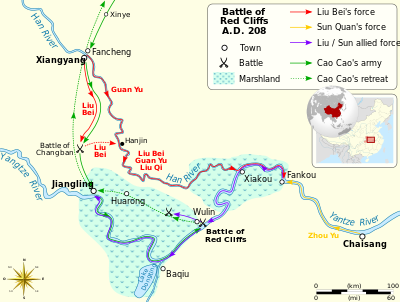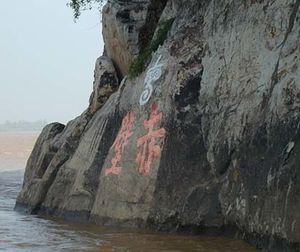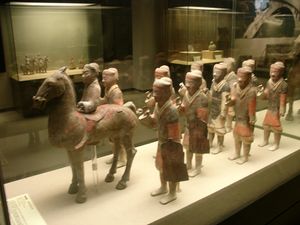معركة المنحدرات الحمراء
| ||||||||||||||||||||||||||||||||
| قالب:Campaignbox Red Cliffs campaign | ||||||||||||||||||||||||||||||||
| ||||||||||||||||||||||||||||||||
معركة المنحدرات الحمراء, otherwise known as the Battle of Chibi, was a decisive battle fought at the نهاية أسرة هان, about twelve years prior to the beginning of the Three Kingdoms period in Chinese history. It was fought in the winter of AD 208/9[2] between the allied forces of the southern warlords Liu Bei and Sun Quan and the numerically superior forces of the northern warlord Cao Cao. Liu Bei and Sun Quan successfully frustrated Cao Cao's effort to conquer the land south of the Yangtze River and reunite the territory of the Eastern Han dynasty. The allied victory at Red Cliffs ensured the survival of Liu Bei and Sun Quan, gave them control of the Yangtze (de Crespigny 1990:273), and provided a line of defence that was the basis for the later creation of the two southern states of Shu Han and Eastern Wu. The battle has been called the largest naval battle in history in terms of numbers involved.[3]
Descriptions of the battle differ widely, and the location of the battle is fiercely debated (de Crespigny 1990:256 78n). Although its precise location remains uncertain, the majority of academic conjectures place it on the south bank of the Yangtze River, southwest of present-day Wuhan and northeast of Baqiu (present-day Yueyang, هونان).
المعركة


تحليل

الأعقاب
الوقع الثقافي
Former Ode on the Red Cliff, A famous poem by Su Shi written أثناء أسرة سونگ - National Palace Museum
الهامش
- ^ أ ب ت See Red Cliffs order of battle for the sources.
- ^ "The engagement at the Red Cliffs took place in the winter of the 13th year of Jian'an, probably about the end of 208."(de Crespigny 1990:264)
- ^ http://militaryhistory.norwich.edu/largest-naval-sea-battles-in-military-history/
ملاحظات
| هذه المقالة تحتوي على نصوص بالصينية. بدون دعم الإظهار المناسب, فقد ترى علامات استفهام ومربعات أو رموز أخرى بدلاً من الحروف الصينية. |
- "11th century writer's statue erected in Hubei province". Xinhua News Agency, January 19, 1983. Retrieved on July 22, 2007.
- "Ancient battlefield turns to tourism site". Xinhua News Agency, June 11, 1997. Retrieved on July 22, 2007.
- Chen, Shou (c. 280), Sanguo zhi (History of the Three Kingdoms), Reprint,1959. Beijing: Zhonghua shuju.
- de Crespigny, Rafe (1969), The Last of the Han: being the chronicle of the years 181-220 AD as recorded in chapters 58–68 of the Tzu-chih t'ung-chien of Ssu-ma Kuang, Canberra: Australian National University, Centre of Oriental Studies.
- de Crespigny, Rafe (1990), Generals of the South: The foundation and early history of the Three Kingdoms state of Wu, Canberra: Australian National University, https://digitalcollections.anu.edu.au/html/1885/42048/gos_index.html. Internet Edition 2004.
- de Crespigny, Rafe (1996), To Establish Peace (Volume 1): being the Chronicle of the Later Han dynasty for the years 189 to 220 AD as recorded in Chapters 59 to 69 of the Zizhi Tongjian of Sima Guang, Canberra: Australian National University, https://digitalcollections.anu.edu.au/html/1885/42048/peace1_index.html. Internet Edition 2004.
- de Crespigny, Rafe (1996), To Establish Peace (Volume 2): being the Chronicle of the Later Han dynasty for the years 189 to 220 AD as recorded in Chapters 59 to 69 of the Zizhi Tongjian of Sima Guang, Canberra: Australian National University, https://digitalcollections.anu.edu.au/html/1885/42048/peace2_index.html. Internet Edition 2004.
- de Crespigny, Rafe (2003), The Three Kingdoms and Western Jin A history of China in the Third Century AD, https://digitalcollections.anu.edu.au/html/1885/42048/3KWJin.html Internet edition.
- de Crespigny, Rafe (2007), A biographical dictionary of Later Han to the Three Kingdoms (23–220 AD), Leiden, The Netherlands: Brill. ISBN 978-90-04-15605-0
- Eikenberry, Karl W. (1994), "The campaigns of Cao Cao", Military Review 74 (8): 56–64.
- Fitzgerald, C.P. (1985), Why China? Recollections of China 1923–1950, Melbourne: Melbourne University Press.
- Pei, Songzhi (429), Sanguozhi zhu
- The Military Documents Research Organization of the Wuhan Military District (1979). Zhongguo Gudai Zhanzheng Yibaili (One Hundred Battles of Ancient Chinese History). Wuhan: Hubei Province People's Publishing House.
- Zhang, Xiugui (2006), "Ancient "Red Cliff" battlefield: a historical-geographic study", Frontiers of History in China 1 (2): 214–35, doi:.


